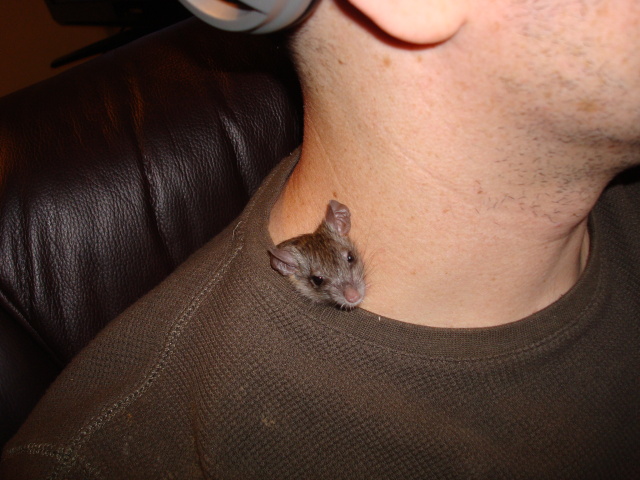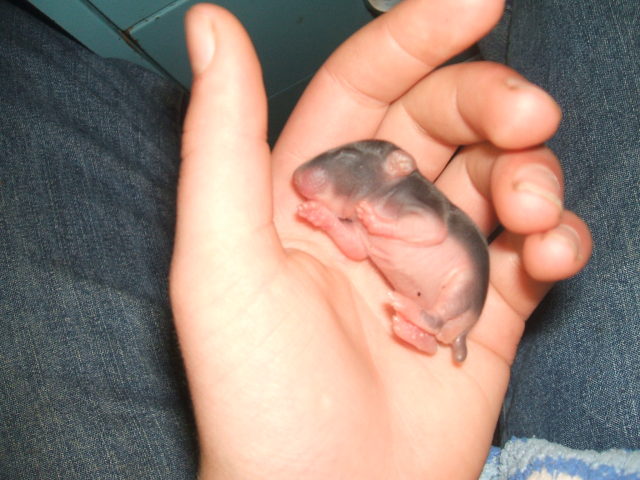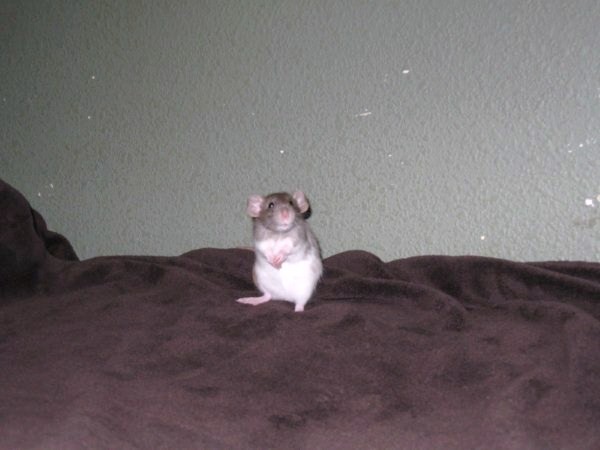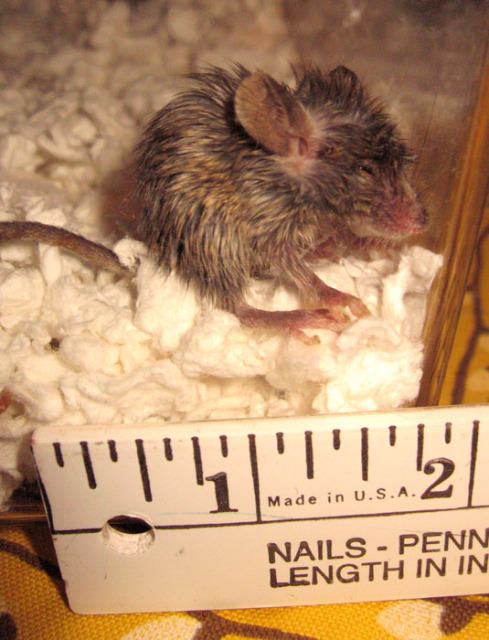QuestionHi Jennifer --
Thank you for all of your good advice. There will actually be two separate aspects to the mouse element for this sculpture installation. The first will be one of these "houses" placed in a basement or other area frequented by wild mice, with a nearby video camera set on time-lapse, filming the mice coming and going over the course of a week or so. I might have to use food to entice them into the house, at least at first, but I don't want to get them to rely on it any longer than the filming period. Also, since part of the idea is to provide mice with shelters to protect them from preditors, without human intervention, feeding them regularly wouldn't fit the plan.
The second element of the project will be in the gallery, with a large terrarium with an identical mouse house set up, with some mice living in it. These will probably be socialized mice from a local source, and food and water will be provided. This will go on for a few weeks, while the exhibition is underway. I'll need to find a source here in the San Francisco area for house mice, and a caring home for them afterwards, unless someone is willing to loan them to me for the duration of the show. Do you know anyone in my area who might be worth contacting? What food would you recommend to entice the wild mice into the shelter, and what food would you recommend feeding the socialized mice during the show? Are there any other things I should supply for either house, such as an infrared heat lamp in the terrarrium, or nesting materials?
The shelters have to be aluminum, for a number of artistic reasons, as well as for durability; wood is too easily damaged. However, I intend to line the mouse nest areas (two in each house--about 5"x7" each) with natural cork, for insulation, for softness, and because the other two animal species included in the project (pigeons, and small coastal fish such as smelt or grunion) will also be housed in shelters made of sheet aluminum and cork.
This project is at least partly about the way that some animals which live in urban or human environments have ambiguous relationships with humans, and the way that humans are indifferent (or even cruel) towards them, while at the same time being protective towards other species, for entirely subjective or irrational reasons. So, in a way, I'm trying to get visitors to the show to see wild mice as something other than "vermin", but rather as sensitive, vulnerable creatures that deserve their own lives, free from human harm. I'll be happy to notify you when the show is about to begin, and to send you pictures afterwards.
Thanks again. -- Robert
-------------------------
Followup To
Question -
I have a rather odd question. I'm a sculptor who is trying to design the ideal shelter for the common house mouse, for use in urban settings (i.e., not as pets). This is for an art installation and it will be totally harmless to the mouse/mice--in fact, the theme of the project is providing security for marginalized creatures; feel free to e-mail me with any questions.
I want to make a small house-like shelter for one mouse, or a few mice, against preditors and against the elements. It will be situated on the ground, against a wall. No food will be provided. Can you tell me what the housing necessities are for a house mouse, as well as what environment might feel welcoming to them? Specifically, I need to know what size and shape an ideal entrance hole would be that would provide ready access but would exclude rats, cats' paws, etc., what the ideal size of a nest area is, whether a reservoir for water (just a trough, not a bottle) would be drunk from if available, and if sheet aluminum would be an objectionable building material to them. Thank you in advance for any information.
Answer -
Dear Robert,
thank you for your question.
This is really an interesting project and I would be very interested in seeing the result.
The shelter should be designed for a group of mice because they are very social and a wild mouse would never live alone (pet mice shouldn't, too). If you plan to house mice in the exhibit, please offer them food. Mice have a rapid metabolism and starve fast, they need food all the time. Water will be accepted and a dish or something similar is actually much more natural for them than a bottle.
Mice prefer small spaces to hide in and can squeeze through tiny holes, so the entrance hole can be very small. A diameter of one inch is more than sufficient and will offer protection from both rats and cats. They like tunnels to run throgh and hate having to walk over open spaces. Sheet aluminium can be used, but I think the mice would prefer wood at least for their nest. They can gnaw it and gice the nest the shape they want.
Mice like to sleep together and prefer small hiding places for this, a flower pot that is 4 inches high and has a diameter of about 4 inches can easily accommodate eight mice, just to give you an example.
I hope this is of some help to you, please let me know if you have any more questions (I'm not at home for the weekend, but will be back on Monday).
Jennifer
AnswerHi,
thanks for giving me the additional imformation. Send me an email to jedediah@web.de when the show begins, this is really interesting. May I post about this and show the pictures in a mouse board I'm a member of, I think the people there will be interested in reading about this?
Cork for the nest is a very good idea, this is even better than wood :)
For feeding the fancy mice I suggest a mixture of a good commercial mouse or gerbil food (Ecotrition for example) mixed 1:2 with bird seeds. Fresh vegetables or fruit such as apple, cucumber, zucchini, carrot, chard, pear, bell pepper ect. is find for them. Millet spray will keep them ooccupied and they love it - I think it might attract the wild mice, too. Exterminators have non-toxic scents they use to attract mice to the bait, maybe you can use those to attract the mice to the shelter.
A heat lamp is not neccessary, but nesting materials are a good idea. Unscented toilet paper or paper tissue is cheap and the mice like it. If you can get kapok, it's worth a try (kapok comes in a pod and when opened, looks a bit like cotton), especially for the wild mice. Rags, for example old cotton t-shirts, make good nesting material.
The terrarium should have some kind of toys for the mice, some branches or ropes to climb for example and/or cork tunnels/cardboard tubes to run through. They don't need a wheel as long as they have other things to keep them entertained.
For finding or "borrowing" fancy mice, the Rat and Mouse Club of America might be of some help to you.
http://www.psyeta.org/hia/vol8/lawlor.html
There's a group in California
http://www.rmca.org/barmca/
I found another link that you might be interested in, it's an essay about the design of the ideal mouse home:
http://www.psyeta.org/hia/vol8/lawlor.html
I hope this help you and I'm really looking forward to seeing the result :)
Jennifer

 wild rat companion?
Questionroof rat
QUESTION: I have been raising a
wild rat companion?
Questionroof rat
QUESTION: I have been raising a
 newborn rodent
QuestionQUESTION: Hello,
My daughter found a 2 3/4 inch
newborn rodent
QuestionQUESTION: Hello,
My daughter found a 2 3/4 inch
 Pet Rats (Temperary itchy skin)
Question
Casey
Hi Dawn,
Pet Rats (Temperary itchy skin)
Question
Casey
Hi Dawn,
 Question about taking care of a young mouse found in a live trap
Questioncandaules
QUESTION: Hallo! The liv
Question about taking care of a young mouse found in a live trap
Questioncandaules
QUESTION: Hallo! The liv
 Rattie question
QuestionHey there:) I recently got two five week old ma
Rattie question
QuestionHey there:) I recently got two five week old ma